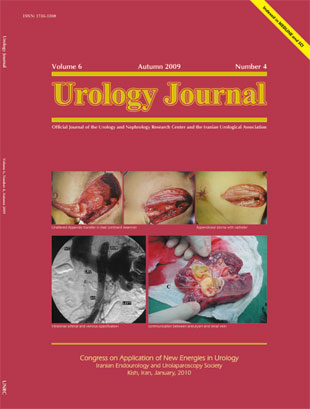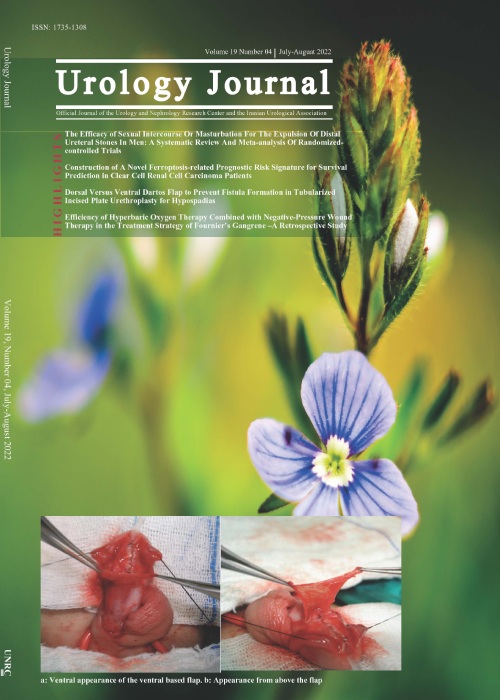فهرست مطالب

Urology Journal
Volume:6 Issue: 4, Autumn 2009
- تاریخ انتشار: 1388/10/10
- تعداد عناوین: 15
-
-
Page 245Introduction
Laparoscopic adrenalectomy remains a controversial procedure for large tumors. The incidence of adrenocortical carcinoma increases and technical difficulty of adrenalectomy increases as the size increases. We examined the outcome and complications of laparoscopic adrenalectomy for such lesions.
Materials And MethodsTwenty-nine patients underwent laparoscopic adrenalectomy, of whom 19 had tumors larger than 5 cm in diameter, having a median tumor size of 7.0 cm. They were compared with patients whose adrenal tumors were smaller than 5 cm.
ResultsPatients with small tumors (< 5 cm) had a significantly shorter median operative time of 90 minutes as compared to 145 minutes in those with large tumors (> 5 cm). There was no significant difference in the median hemoglobin drop (1.05 g/dL versus 1.30 g/dL), time for starting oral intake (24 hours in both groups) or hospital stay (3.5 days versus 4.0 days) between patients with small and large tumors, respectively. There were no intra-operative complications except for 1 incidence of supraventricular tachycardia in a patient with a large pheochromocytoma. There were no major complications seen in any of the patients and no open conversions. Histopathology of large tumors revealed 16 benign tumors (8 pheochromocytomas, 4 adenomas, 2 ganglioneuromas, 1 pseudocyst, and 1 myelolipoma) and 3 malignancies, of which 1 was primary adrenocortical carcinoma and 2 were metastatic renal cell carcinoma.
ConclusionIn experienced hands, laparoscopic adrenalectomy is safe and feasible for large functioning adrenal tumors. Large adrenal tumors suspicious of harboring malignancy with no peri-adrenal involvement can be tackled laparoscopically.
-
Page 249Introduction
We evaluated the safety of sterile water as an irrigationsolution for percutaneous nephrolithotomy (PCNL).
Materials And MethodsForty-four patients with kidney calculi wereenrolled in this study and randomly divided into two groups for PCNL.Approaches to the calculi were through a single subcostal access with anAmplatz sheath, and either sterile water or isotonic saline solution was usedas the irrigation fluid. Serum hemoglobin, haptoglobin, sodium, potassium,and creatinine were measured before and 12 hours after the procedure. Thepatients were evaluated for signs of transurethral resection of the prostatesyndrome during the operation for 24 hours afterwards.
ResultsThe mean calculus size, irrigation volume, irrigation time, and agewere not significantly different between the two groups. Hemolysis occurredin 10 and 9 patients in sterile water and saline groups, respectively. The meanchange in haptoglobin level was -1.7 ± 59 mg/dL in the sterile water and 11 ±55 mg/dL in the saline group. Also, the mean change in plasma sodium levelwas -2.2 ± 4.7 and -0.4 ± 3.8 in sterile water and saline groups, respectively.None of these values were significantly different between the two groups, norwere other laboratory values. None of the patients developed transurethralresection of the prostate syndrome or needed transfusion.
ConclusionSterile water is an inexpensive alternative to isotonic saline forirrigation during PCNL. We did not find any difference between the twoirrigation solutions regarding the safety; however, this should be confirmedfurther, especially for larger calculi.
-
Page 260Introduction
We compared the best technique for arterial anastomosis in kidney transplantation, end-to-side anastomosis to the external iliac artery or end-to-end anastomosis to the internal iliac artery.
Materials And MethodsA total of 38 patients with end-stage renal disease who received a kidney transplant from a deceased donor were randomized into two groups in order to undergo either end-to-end anastomosis to the internal iliac artery or end-to-side anastomosis to the external iliac artery. Length of arterial anastomosis, cold ischemia time, hospital stay, serum creatinine level, recovery of urinary output, and surgical and clinical complications during hospitalization were evaluated. After 3 years, in the patients with a functioning allograft, creatinine clearance measure, Doppler ultrasonographic study, survival, graft loss, and erectile function were compared between the two groups.
ResultsPostoperative analyses showed similar recovery of urinary output (P =. 39) and creatinine (P =. 95) between the two groups. No differences in clinical (P =. 55) and surgical (P =. 80) complications or in hospital stay (P =. 90) were noted. The 3-year follow-up demonstrated no differences in Doppler ultrasonography results, creatinine clearance (P =. 80), patient survival (P =. 22), and graft loss (P =. 72). Erectile dysfunction was similar, being related only to pre-operative medical history and age.
ConclusionBoth techniques showed similar results in short- and long-term follow-ups. Larger prospective studies are warranted to clarify the risk of renal artery stenosis and development of erectile dysfunction.
-
Page 267Introduction
Erectile dysfunction has usually been treated by a phosphodiesterase 5 inhibitor in men, especially in the past decade. Although sildenafil and vardenafil are widely used, there is a high percentage of people who do not respond to these drugs. This study was performed in order to evaluate the efficacy of the lastly presented phosphodiesterase 5 inhibitor, tadalafil, in nonresponder group of patients to sildenafil and vardenafil.
Materials And MethodsForty married men with erectile dysfunction who had taken sildenafil or vardenafil at the maximum recommended doses and had not responded to the treatment were included. They were treated with tadalafil, 20 mg, at least 4 doses at different days. The effectiveness of the treatment was reviewed by different questionnaires, including the International Index of Erectile Function-5 (IIEF-5), Sexual Encounter Profile (SEP) questions 2 and 3, and the Global Assessment Question (GAQ), at the end of the 12th week.
ResultsThe IIEF-5 scores were 11.90 ± 4.78 and 12.67±6.70, before and after at least 4 doses of tadalafil, respectively (P =. 30). The rate of positive responses to SEP2, SEP3, and GAQ questions were also insignificantly different after the treatment. During this period, flushing was seen in 10 and headache was seen in 5 patients.
ConclusionThe recommended maximum dose for tadalafil insignificantly improved the IIEF5, SEP2, SEP3, and GAQ scores in patients with erectile dysfunction who had not responded to sildenafil and vardenafil. The other treatment alternatives should be in mind after getting no response to the optimum doses and enough trials of sildenafil or vardenafil before trying a tadalafil regimen
-
Page 272Introduction
The objective of the present study was to evaluate the results and the complications of delayed retropubic urethroplasty of completely transected urethra associated with pelvic fracture in girls.
Materials And MethodsFrom 2002 to 2008, a total of 7 girls with complete urethral disruption after pelvic fracture were referred to our center and all of them underwent delayed retropubic urethroplasty with end-to-end anastomosis of the urethra.
ResultsSeven female patients with a median age of 6 years old underwent delayed end-to-end anastomosis. The median time to surgery was 6 months from the trauma. Voiding was normal after catheter removal in all of the patients. The median follow-up was 36 months. Three patients had mild stress urinary incontinence after catheter removal.
ConclusionThere are some different strategies for management of complete urethral avulsion in females who have sustained pelvic fracture, including early realignment, bladder flaps, and end-to-end anastomosis. The strategy of delayed end-to-end anastomosis urethroplasty with retropubic approach is sound and produces acceptable results. The use of flexible cystoscope and omental flap is effective in achieving continence after urethroplasty in such cases
Keywords: pelvic bones, bonefractures, female, urethra, urologicsurgical procedures, urinaryincontinence -
Page 276Introduction
We report a new modified technique of unaltered appendix transfer to ileal pouch and preserving ileocecal segment. This modification enables us to use ileum as the popular type of enteric segment instead of ileocecal segment while using appendix as a catheterizable stoma.
Materials And MethodsForty-five patients (30 men) who needed reconstruction of the lower urinary tract were enrolled for using appendix as a catheterizable stoma. Reservoir was reconstructed using ileal segment. The appendix was circumcised from its base over its pedicle. The spatulated appendix tip was exteriorized as a catheterizable stoma to the skin, preferably umbilicus, and its base was implanted to the ileal pouch.
ResultsFollow-up records of 38 of 45 patients were available. The median follow-up period was 29 months. The mean intermittent catheterization interval was 4.19 ± 1.6 hours. Urodynamic parameters were evaluated for 18 out of 38 patients. The median maximal pouch capacity determined as 380 mL. The median appendiceal closure pressure was 61 cm H2O. No pouch perforation occurred. Stomal stenosis occurred in 3 patients. They did not catheterize their appendiceal stoma because they restarted catheterization through the urethra.
ConclusionThis novel approach enabled us to use ileum as today''s more popular type of bowel segment to reconstruct enteric pouch rather than using ileocecal segment, while using appendix as a catheterizable stoma. One of the unique advantages of this technique is that the postponement of clean intermittent catheterization will not result in pouch perforation since the urine will leak when the pouch becomes overfill.
Keywords: appendix, ileum, urinaryreservoirs, urinary diversionmethods -
Page 283Introduction
Our aim was to evaluate the natural behavior, growth pattern, morphology, and specific features of human bladder smooth muscle cells (HBSMCs) on two different matrixes, including human amniotic membrane (HAM) and collagen.
Materials And MethodsThe HBSMCs were obtained from 6 children with primary vesicoureteral reflux undergoing open antireflux surgery, and they were isolated from the anterior wall of the bladder. The specimens were cultured on a tissue culture plate of bovine dermal collagen serving as control and on decellularized HAM. Histological, transmission electron microscopy, and immunocytochemical examinations were done, thereafter.
ResultsOn HAM, very few HBSMCs slowly migrated from explant tissue on the 7th day of culture. All the cells were placed at the same direction, and in some parts, formed multilayer. After 35 to 40 days, the confluency rate was 75% and the cells were orderly arranged. On collagen, cell migration from explant culture took place as rapidly as the 3rd to 4th day of culturing. On days 30 to 40, the confluency rate was 100%. Immunocytochemical staining was positive for anti-actin and antidesmin antibodies. On transmission electron microscopy, cell organelles of HBSMCs exhibited the same features of the natural smooth muscle cells. They were tightly attached to each other and the underlying layer basement membrane.
ConclusionA well-designed growth pattern of HBSMCs on HAM with abundant cell-to-cell adhesions encourages us to use it as a competent tissue for reconstruction of relatively damaged or diseased bladders. Undoubtedly, further clinical studies should be performed to replicate our results.
Keywords: cell culture techniques, bladder, smooth muscles, amnion -
Page 289Introduction
During nephrogenesis, transition of mesenchyme to the epithelium of tubules and glomeruli occurs via the interaction of ureteral bud and metanephric mesenchyme. The distribution pattern of collagen type IV suggests that a regulated balance of activities is required to facilitate migration of the ureteral bud branches into the mesenchyme and to control early extracellular matrix changes during tubulogenesis. We used a specific antibody for tracing collagen type IV basement membrane during renal tubules morphogenesis.
Materials And MethodsTwenty female Balb/C mice were divided randomly into 10 groups and were kept until finding vaginal plug was as an indicator of day zero of pregnancy. Twelve pregnant mice were sacrified by cervical dislocation in one of gestational days 13 to 18 and their fetuses were fixed, serially sectioned, and underwent immunohistochemical study for tracing of collagen type IV in basement membrane of glomeruli. The same processes were used for kidneys preparation on postnatal days 5, 10, 15, and 20 in newborns of 2 mothers for each day.
ResultsCollagen type IV showed weak reaction on day 14 of gestation in tubular basement membrane. The amount of collagen increased continuously until the following days of fetal life and of the first 5 postnatal days in basement membrane. After this period, collagen type IV reaction was not showed significant change in newborns.
ConclusionThese results indicate that developmental changes in various nephron segments from most immature stages to most differentiated structures are dependent on the collagen type IV expression
Keywords: collagen type IV, basement membrane, kidneys


